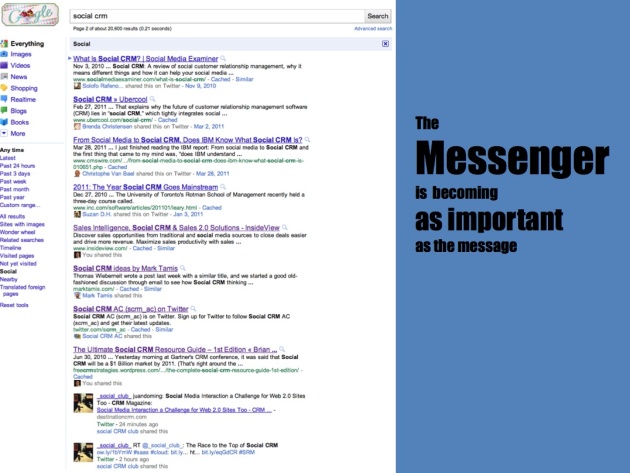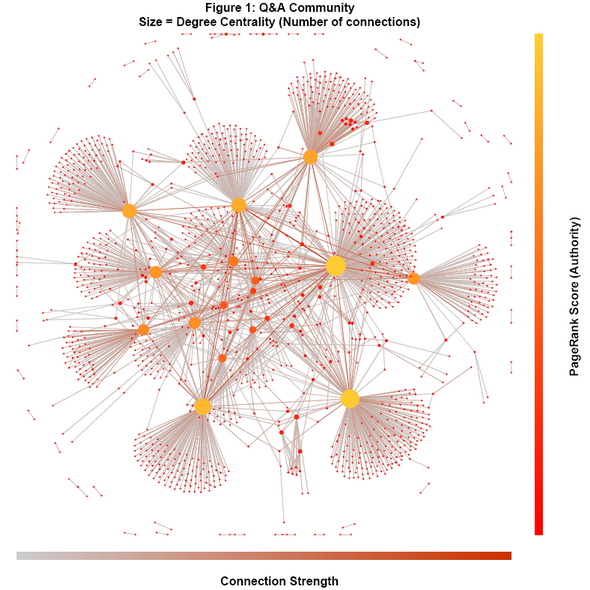When SugarCRM asked me to assemble the social track for SugarCon, the first thing that impressed me was the “spirit” of the track, and conference for that matter. It had little to do with touting Sugar; the company, or the products they make. Rather, it was all about creating a gathering of thought leaders, practitioners, and vendors to mutually work together in the effort of taking the next leap in improving customer relationships.
The great thing about working in collaboration with an open source company is that they “get” stuff like “open”, “collaboration” and “community”. It seems to be just naturally in their DNA and has been since their inception.

I am excited about the lineup. The quality of speakers is amazing, and contains a diversity of perspectives that is hard to emulate, especially at a vendor conference. If you are free April 4-6, 2011, please mark your calendars and plan to attend SugarCon.
Considering that the price for the entire event is far less than what these folks normally charge for an hour of their time, plus the invaluable benefit of networking with other executives, marketers, sales folks, and technologists, it makes it a no-brainer if you can attend. Add to that the additional keynotes, 5 additional tracks, and it’s truly an event you won’t want to miss.
***** To make it even sweeter, mention the special discount code #SCON040511 and get $150 off. *****
Here’s a quick breakdown of the presenter’s lineup, chalk full of folks who have a reputation of keynoting on their own.

Paul Greenberg
Paul will be keynoting the event. If you don’t know who Paul Greenberg is, you probably “have been very busy”. He’s written four versions of the best selling book, “CRM at the Speed of Light”, is an independent analyst, and a well respected consultant to some of the largest and well known CRM vendors in the world. He coined the most used definition of Social CRM, and has energized an industry with his research, intelligence, signature writing style, inquisitive mind, and kind and generous nature. Paul was the mastermind and primary catalyst behind one of the most unique and powerful events I have been to almost exactly a year ago, which has since quite literally propelled an industry (Social CRM) that Gartner is now saying is greater than a $1 Billion marketplace. Paul is well worth the price of admission alone.
By the way, there’s another one of these now famous #scrmsummit events coming up next month (March) in Madrid, Spain if you can make it.

Esteban Kolsky
If you clicked on the Madrid, Spain “Social CRM Strategies for Business” link, you probably saw a picture of Esteban dropping knowledge in a purple shirt and a shiny blue tie. While he likely won’t be wearing a suit, he most definitely will be dropping knowledge about the evolution of social and CRM to this point in time, and will be leveraging his extensive research experience (former Gartner analyst) to paint his view of the coming “collaborative enterprise”. Esteban is one of the sharpest minds in the space, and possesses a great blend of experience (analyst, consultant, practitioner), and background (an Argentinian of Eastern European descent that floats around Silicon Valley). He’s also got a great sense of humor. You won’t want to miss his session.

Dr. Natalie Petouhoff
One of two PhDs. in the lineup, “Dr. Natalie” made quite a splash last year when she jumped from Forrester Research as a Customer Service analyst to take a role as “Chief Strategist” for Weber Shandwick, one of the world’s leading global public relations firms. In fact, Weber Shandwick was just named global agency of the year, for the second year in a row. In addition to being an actual rocket scientist, Dr. Natalie has written multiple books, is a university professor, and has led organizations in a wide variety of capacities as an analyst, consultant, and senior executive. Bringing together a depth of varied experience and a warm and entertaining style, Dr. Natalie will inspire new thoughts and ideas for you to take back to your organization.

Adrian Ott
There’s not many people who have been called “Silicon Valley’s Most Respected Strategist”. Her consulting work is rooted in 18 years of corporate experience, and Adrian recently wrote and published her award winning book “The 24 hour Customer” which takes an intriguing look at why time is more valuable than money, and why and how to work with attention deprived customers. She’s appeared on Bloomberg TV, BusinessWeek, The Washington Post, and other major media for her research and insights about growing businesses in today’s exponential economy. Seriously good stuff. That’s all there is to it.

Dan Zarrella
Dan is the original Social Media Scientist. Beneath the hype and hyperbole of the social media evolution, one guy has a reputation of looking deeply into the numbers and producing insights and takeaways that often fly in the face of the mainstream cheerleaders. He knows why certain tweets gets retweeted, and when and why to post certain messages on your facebook page. He is the author of The Facebook Marketing Book and the Social Media Marketing Book. Based on his research, he knows what day and what time you should blog, or tweet. Hubspot is leveraging guys like Dan to fuel exponential growth. Take copious notes when you’re listening to Dan because they’ll translate to success and dollars when you’re back in the office.

Dr. Michael Wu
Speaking of scientists, Dr. Michael Wu is taking some of the most complicated subjects underpinning the social web, social business, and social networks, dissecting them and then educating the masses with detailed yet digestible explanations of how things really work and how successful organizations can leverage networks to thrive. As the principal scientist of Lithium Technologies, a leader in Gartner’s Social CRM Magic Quadrant, and the pioneer platform provider for customer communities, Dr. Wu has access to a boatload of data, and he slices and dices it with precision. The output is keen insights into why some communities, organizations, and individuals thrive on the social web, and others don’t. Dr. Wu will teach you how seemingly far reaching concepts such as influence, gaming dynamics, and other factors can be key differentiators between marketing and customer service success and failure.

Becky Carroll
What Becky Carroll is working on now could be enough for most people to complete in a lifetime. She’s a professor at UC San Diego, an NBC news correspondent, book author, consultant, and manages the Verizon customer community. She’s long been an author of one of the most popular blogs in the world focused on customer service and customer experience. Entertaining, multi-talented, and engaging, she understands the social world well, and knows what works with customers. Soak up her wisdom and add to your bottom line.

Christopher Carfi
Christopher started his blog called “The Social Customer Manifesto” in 2004! He saw today’s reality nearly a decade ahead of it’s time, and is now looking ahead at the future and the impact of the perfect storm mashup of social, mobile, and cloud computing and what it means for consumers, and in turn, the organizations that seek to earn their business. After nearly a decade at Anderson consulting, he founded Cerado, Inc. to provide software and services that enable businesses, organizations and associations to better connect and understand their customer and member communities. He recently joined Edelman Digital, the digital arm of the largest, independently owned communications firm in the world, Edelman, the publishers of the Edelman Trust Barometer, the subject of my last blog post.

Brent Leary
Another guy who was early to the game, Brent literally started the social crm conversation on Twitter back in 2008 by creating the #scrm hashtag and bringing together a community of thousands to discuss the topic. He co-authored Barack 2.0, chronicling how Barack Obama leveraged Social Media on the way to the presidential election. Brent is the principal and founder of CRM Essentials, and is a well respected analyst, consultant, and thought leader. His thoughts are regularly featured in Inc. magazine, OPEN by American Express, and he’s been quoted in several national business publications, including the Wall Street Journal, Newsweek and Entrepreneur magazine. Brent specializes in the SMB market and always has unique, relevant and actionable insights to share.

Laurence Buchanan
Laurence heads up CRM and Social CRM within the UK for Capgemini (Technology Services). In his current role Laurence is responsible for Capgemini’s CRM & Social CRM go-to-market strategy and business development across all packaged vendors and industries. He is passionate about helping clients articulate their customer-centric vision and strategy, and enabling that through the smart use of technology. Prior to Capgemini, Laurence spent a decade with SAP, where he was global vice president for SAP CRM. He is a recognised authority and evangelist on CRM, Social CRM and customer experience transformation. He writes regularly on Social CRM at The Customer Revolution and is a member of the CRM advisory board at the Rotman Centre for CRM excellence in Toronto.

Matthew Rosenhaft
Matthew Rosenhaft is the Principal of Social Gastronomy and Co-Founder of the Social Executive Council, an elite group of global CxOs, focused on leveraging social technologies in their organizations. He is a former marketing executive who specializes in Social Business, Marketing, and Architecture Strategy. He also has founded several early-stage venture-backed technology companies and holds a US patent for a mobile marketing technology. You won’t want to miss Matthew’s session as he unveils the research findings of his firm, and provides an ultra-tangible example of how companies can leverage social market research to provide insight into strategic customer focused initiatives. The subject of his research? SugarCRM. Come attend this no-holds barred session as Matthew unveils clues to Sugar about what the marketplace and prospective buyers think about them, and offers some suggestions about how they might respond.
That’s the lineup. What are you waiting for? Register here, save some cash with the #SCON040511 discount code, and let’s setup a time to connect while you’re there.

































Recent Comments